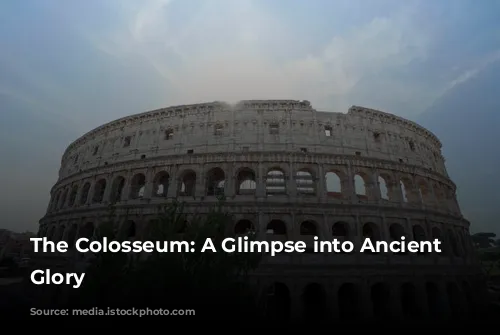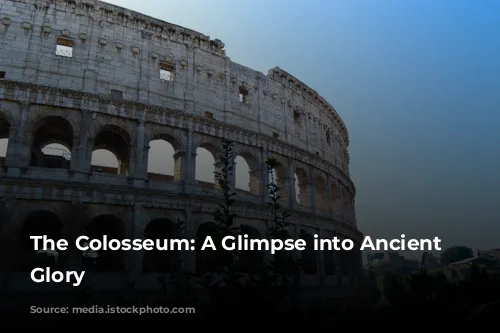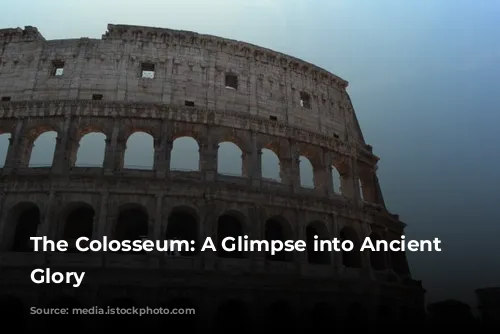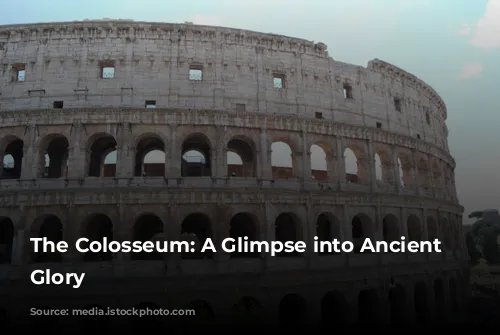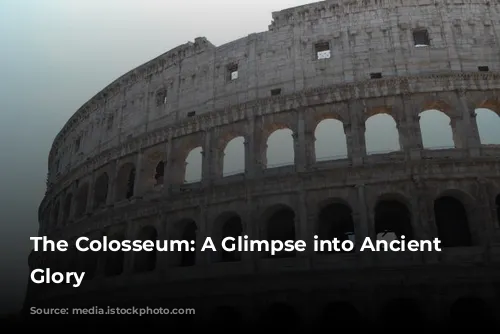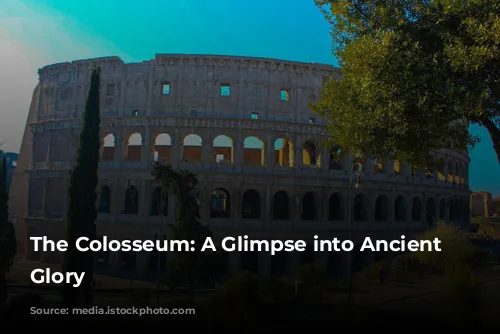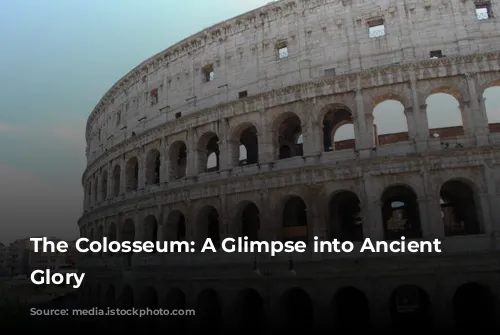The Colosseum, also known as the Flavian Amphitheatre, is a monumental structure that stands as a testament to the grandeur of the Roman Empire. This iconic landmark, the largest amphitheatre ever built in the Roman world, is a must-see for anyone visiting the Eternal City.
A Monumental Beginning
The Colosseum was commissioned by Emperor Vespasian, a member of the Flavian dynasty, and inaugurated by his son, Titus, in the year 80 A.D. The opening ceremony was an extravagant spectacle that lasted for a staggering one hundred days! The crowds were entertained with a dazzling array of gladiatorial combats, animal hunts, and theatrical performances. One of the most memorable events was a naumachia, a simulated sea battle staged in the arena, filled with water. Imagine the awe and wonder of witnessing such a spectacular display!
The Colosseum’s Name: A Tale of Prophecy and Statues
But why is it called the Colosseum? The name first appeared in a prophecy made by the Venerable Bede, a medieval monk, who stated: “Rome will exist as long as the Colosseum does; when the Colosseum falls so will Rome; when Rome falls so will the world.” He might have been inspired by the colossal statue of Emperor Nero, known as the “Colossus,” which once stood next to the amphitheatre. This magnificent statue, towering 35 meters tall, has sadly been destroyed.
Architectural Brilliance: A Symphony of Arches
The Roman Colosseum is an architectural marvel, constructed from gleaming white travertine stone. Its elliptical shape ensured that every spectator could enjoy a clear view of the arena. The structure was divided into four levels, with the first three featuring eighty arches each. These arches were adorned with stunning statues, adding to the Colosseum’s grandeur.
This massive structure was built in a remarkably short time, just ten years! The secret to its construction lay in the Romans’ mastery of arch construction. They understood that the arch allowed them to distribute the weight of massive structures efficiently. This knowledge enabled them to build impressive aqueducts, bridges, and, of course, the Colosseum.
Time’s Unrelenting Grip: A Legacy of Decay and Transformation
Over time, the Colosseum has undergone significant changes. Today, only a fraction of its original exterior wall remains, with three-fifths missing. During the Middle Ages, the once glorious arena was plundered for its materials, contributing to the construction of other famous Roman landmarks like the Barberini Palace, Piazza Venezia, and even St. Peter’s Basilica. The holes in the Colosseum’s columns are a poignant reminder of this past.
A Venue for All: Spectators and Social Hierarchy
The Colosseum could accommodate up to 70,000 spectators, offering a unique and engaging experience. The tiers of seats were carefully designed to ensure optimal visibility for everyone. Entry was free for Roman citizens, but seating was assigned based on social status, much like modern theatres. The commoners sat in the upper tiers, while the elite occupied the lower seats. Senators, Vestals, priests, and, of course, the emperor, enjoyed the best views from the front row.
A Triumph of Engineering: The Colosseum’s Sunshade
The Colosseum was a marvel of engineering, even boasting a sophisticated sunshade system known as the velarium. This ingenious structure was a giant linen awning suspended by ropes, winches, and wooden poles attached to the upper wall. It took a hundred sailors from the Imperial fleet to maneuver the velarium, moving in perfect synchronization to the rhythm of a drum.
The Gladiators: Legends of the Arena
Stepping inside the Colosseum, we are transported back in time to witness the thrilling spectacles that once unfolded within its walls. The arena floor, once a combination of brick and wood, has vanished, leaving behind cellars that housed the equipment used for the games.
The underground floors were equipped with lifts and hoists, complete with counterweights, which allowed gladiators and animals to make dramatic entrances through trapdoors, creating awe-inspiring effects. The complex system of hinges and lifts was also used to raise and lower elaborate backdrops for hunting events.
Entertaining the Masses: Shows of Strength and Symbolism
The shows at the Colosseum served a dual purpose. They entertained the masses, distracting them from political issues, and reinforced the bond between the citizens and their leader through shared experiences. The events were a fascinating blend of spectacle and symbolism, reflecting the values and beliefs of ancient Rome.
A Glimpse into the Colosseum’s Diverse Shows
The Colosseum hosted a variety of shows, each with its own distinct character. Venationes (animal hunts) took place in the morning, featuring exotic animals fighting each other or facing off against human opponents. These events could also serve as forms of public execution, with condemned criminals left at the mercy of ferocious beasts.
The Silvae (forest hunts) were particularly spectacular. Painters and set designers recreated woodland scenes within the arena, complete with trees, bushes, and animals. These hunts were often staged without the animals being killed, demonstrating the Romans’ skill in creating immersive experiences.
The Gladiators: Heroes of the Arena
The highlight of the Colosseum’s performances was undoubtedly the gladiatorial contests. The gladiators were trained fighters, often former prisoners of war or individuals seeking fame and fortune. They were revered by the crowd and enjoyed immense popularity, particularly among women, who often showered them with affection.
There were twelve distinct types of gladiators, each with their own unique weaponry and fighting style. The Retiarius fought with a net, trident, and knife, while others wielded shields, sickles, and javelins. The gladiators were carefully chosen for their skills and matched against opponents to create dramatic encounters.
The Audience’s Power: Life or Death
The crowd held immense power in the gladiatorial arena. If a defeated gladiator was wounded, they could plead for mercy by raising an arm. The audience would then shout to the emperor, who sat on his elevated platform, to spare the gladiator’s life or pronounce their death. The emperor’s decision was final: a thumbs up meant life, a thumbs down meant death.
The victors were rewarded with golden palm leaves and substantial sums of money. After each battle, servants, dressed like Charon, the ferryman of the Underworld, ensured that the wounded were truly dead, if necessary, finishing them off. Gladiators’ blood was believed to have healing powers, particularly for epilepsy and sexual potency.
A Violent Spectacle: The Brutal Reality of the Colosseum
Roman spectators reveled in brutal entertainment, often involving violence and bloodshed. These events were not unlike modern-day “splatter” films, with one crucial difference: the raw, visceral reality. The smell of blood, burnt flesh, and wild animals permeated the air, creating an overwhelming sensory experience. Despite attempts to mask the stench with incense and perfumes, the true nature of the Colosseum’s shows remained undeniable.
From Glory to Decay: The Colosseum’s Legacy
After the decline of the Roman Empire, the Colosseum fell into disuse. Its walls became home to various groups, including confraternities, hospitals, hermits, and even a cemetery.
From the Middle Ages onwards, the Colosseum has been a source of wonder and awe, attracting visitors from all corners of the world. At one point, it was even threatened with demolition, but Pope Benedict XIV intervened, declaring it a sacred monument dedicated to the Passion of Christ. A cross was placed on a pedestal, symbolizing the suffering of Christian martyrs, and marking the starting point for the Stations of the Cross on Good Friday.
A Timeless Symbol: The Colosseum’s Enduring Appeal
The Colosseum has become an enduring symbol of Rome’s glorious past and a powerful testament to the human spirit. As Charles Dickens eloquently wrote, seeing the Colosseum is like “seeing the ghost of old Rome floating over the places its people walk in.” Today, it stands as a reminder of a bygone era, a source of inspiration and intrigue for generations to come.
